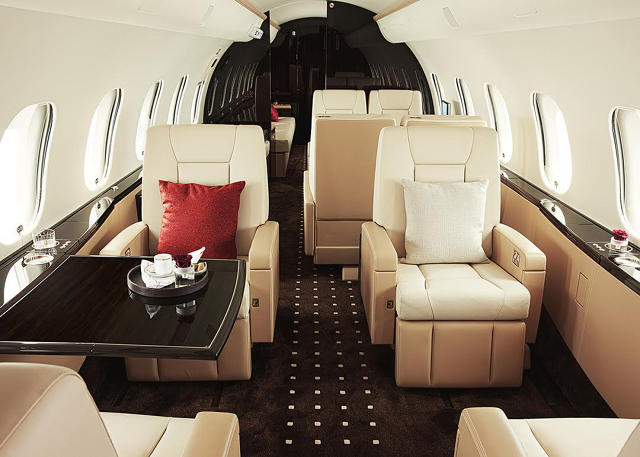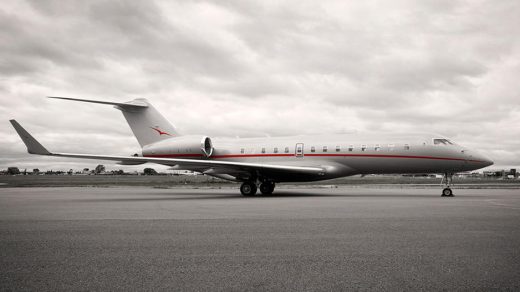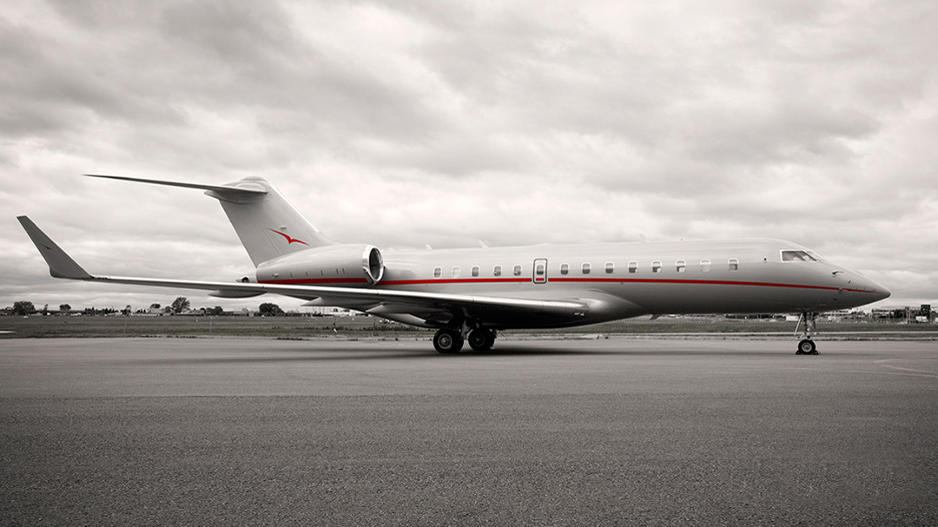Can VistaJet Become The Uber Of Private Aviation?
For some heavy hitters in Silicon Valley, any old private jet just won’t do. Leather seats? Basic. A Bloody Mary after launch? Boring. But one luxury air-travel company is introducing more personalized, high-end amenities, with everything from cashmere eye masks to mixologist-approved cocktail menus.
The Swiss company VistaJet offers amenities that go beyond the luxury norm: The cabin crew is decked out in designer Moncler uniforms and trained by the British Butler Institute. Passengers can browse a library curated by the London-based bookstore Heywood Hill, and there’s even a custom aircraft fragrance, designed by perfumier Le Labo.

Food and drink options include VistaJet’s own branded caviar, a Nobu menu, and renowned mixologist Simone Caporale’s global-inspired cocktail collection. When customers order a classic gin and tonic, it comes “with an essence of Indian spice.”
Then there’s the sleep preparation program, where clients receive special pajamas and relaxing herbal teas prior to resting on Egyptian cotton linens, feather duvets, and cashmere blankets.
As VistaJet Creative Director Nina Flohr says, the company is trying to distinguish itself by being “simple yet out of the ordinary.” While other private aviation providers might only offer the standard Bloody Mary out of a premixed can, VistaJet believes it’s the details that make all the difference: Nobu sake, for instance, complemented with organic black cherries or whatever the passenger prefers. The cabin crew is trained to discreetly keep tabs on each customer and update their files with details of their preferences. VistaJet wants to personalize the experience of flying private.
“They’re busy people, they’re always on the go, so what we’re trying to capture with our cabin experience is that home away from home,” Flohr says. For example, if the crew notices that a customer prefers Moroccan mint tea, they will ensure that there is mint tea available on the passenger’s next flight. The crew will even note how the passenger likes it served: with sugar or without? “These are little things that are not spoken about, but are noticed and used to build that customer’s profile.”
VistaJet, which flies to 182 countries, claims to be the fastest-growing worldwide jet company. Its global flight traffic grew 20% year over year for the last three years, with over 400% growth since it entered the U.S. market in 2013. It currently has over 70 super-mid to ultra-long-range business jets, but plans to expand to 100 aircraft in the coming years to further compete with more established companies like NetJets.
VistaJet is popular with startup founders and VCs who can book flights with the company’s app within 24 hours of the desired departure. It’s already embedded in the industry’s culture: It was the first business aviation provider to use Facebook At Work, the social network’s new internal communications platform.
VistaJet’s success is partially due to its unique structuring. The company only charges clients for the leg they fly (roughly $15,000 an hour), versus traditional charter companies, which bill for the return leg, landing costs, or base resting. That means you only pay one way for the actual hours in the air—an attractive offer for those accustomed to the sharing economy.
“We are finding that most in the tech industry would prefer to have access to a fleet of aircraft, rather than own one or two planes,” says Thomas Fry, VistaJet’s marketing director. “Our business model of an asset-free flight solution is very appealing.”
Starting with the 2008 recession, more and more American businesses sought to offload company jets—often a $50 million responsibility. “A lot of boards and stockholders no longer like to see a private jet on the books,” VistaJet President Ronald M. Silverman says.
With VistaJet, executives can receive virtually identical perks for substantially less money and without the burden of maintaining and storing an expensive asset. It’s an alternative to the fractional market—in which you essentially own a piece of a private plane, somewhat like the timeshare market—which is increasingly hurt by the residual value of owning a private plane. Depreciation can go down by as much as 40% in five years.

VistaJet owns its entire fleet. Ten planes are based in the U.S. and 70 worldwide; their average age is 18 months. After five years, they are replaced with newer models. “We are truly the only company that can offer consistent new aircrafts,” Silverman says.
This is crucial, since today’s business leaders are more demanding than ever before. Since the hotel and restaurant industry raised the level of premium service, customers expect the same of every market. Silverman likens VistaJet to the Four Seasons: No matter which location a guest checks into, they will receive excellent treatment.
“The general public who flies in private airplanes these days are much more educated and aviation savvy than they were 10 years ago,” Silverman says. “They want to fly in the newest, most sophisticated airplanes, and they want to receive the highest level of service.”
Sheree Ladove Funsch is a founder of both established and up-and-coming beauty brands, including Bed Head and Rikoko. She prefers VistaJet for her globetrotting business trips because of the flexibility and cabin experience.
“With businesses around the world, my husband and I need a global solution that accommodates many different types of trips, so owning one aircraft or a fraction of one doesn’t work for us,” she says via email. “We pay for occupied hours only, give very little notice when we are ready to depart, and everything is included, from a cabin hostess to catering from the best restaurants and hotels in the world.”
In recent years, the industry has seen an influx of startups aiming to disrupt the private aviation industry, which is worth $14 billion. JetBlue just invested in JetSuite, which currently flies to seven U.S. destinations. There’s also the on-demand jet-hire company Victor, which boasts a popular booking app.
But innovating in the private jet space is much more difficult than disrupting the taxi industry. As Milton Pedraza, CEO of the Luxury Institute says, this is a market with rather flat growth and a laundry list of complexities. “Everyone is trying to be the Uber of the private aviation industry, and it’s not that simple,” he says. “This industry is extremely hard to quantify between charter and all the different players that exist.”
Unpredictable weather, pilot unions, airport regulations, and jet maintenance are just a few of the costly obstacles plaguing private aviation. Generally, charter planes are not owned by their management company, which means brokers must check with the owners for any new changes or modifications. With numerous variables, the market still depends on the traditional travel agent to piece together all the moving parts: The client might want to stop off in a random city, or bring a few friends, or cancel last minute.
“The complexity of the business demands relationships and exceptions and all kinds of requirements,” Pedraza says. “Because [clients’] lives are far more complex, they’re demanding more exceptions.”
There’s a heavy push to expand the market, says Doug Gollan, editor of DG Amazing Experiences, a weekly travel e-newsletter for private jet owners. But newcomers need to understand the psychology of their customer base. “The market for people who can afford private aviation is fairly finite,” he says. “You’re not talking about the top 1%; you’re really talking about the top 10% of the top 1%.”
Gollan points to the last century, in which entrepreneurs were keen to start commercial airlines, until they realized how difficult a market it can be. “Now the hot, trendy thing to do is get some investment money and start a private jet company,” he laughs.
Gollan points to many of the startups attempting to simplify and lower the cost of the charter experience: JetSuiteX converts non-brand-new regional jets into charter planes, then operates them out of private jet terminals, while “ride-share” startups such as JetSmarter connect passengers to chartered flights on various planes for membership fees. Both models tie the client to additional guests’ schedules. That means you can’t depart whenever you want. And in that case, some travelers might still prefer to pay an agent to find a schedule that matches their specific needs. That suggests some degree of professional security for travel agents, as long as they can adapt to industry changes and startups cultivate relationships with them.
“This is one of the toughest industries, and because it’s one of the toughest, a lot of the pretenders go out of business quickly,” says Pedraza, noting that charter agents aren’t going anywhere anytime soon. “The innovation is the relationships.”
A company such as VistaJet, which Gollan calls the “Tiffany of private jet providers,” has crafted a unique position in the market: Targeting luxury consumers and Silicon Valley executives who crave dependability and personalization. That in itself might be the new way of building lasting relationships. “You know what you’re getting each time,” he says. Not every CEO values a Nobu menu or designer slippers, he admits, but a good many do.
Flohr, however, sees the personalization trend only growing stronger within the luxury sector. “You can relate this to any industry: People want to have a voice and they want to be someone,” she says. “They don’t just want to be a number.”
Unless, of course, that number corresponds to how many organic sugar cubes you take in your tea.
Fast Company , Read Full Story
(39)














